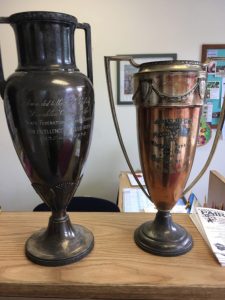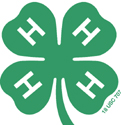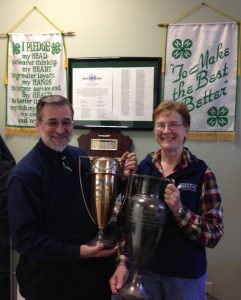4-H Fix: The 4-H Silver Cups of Franklin County
The 4-H Silver Cups of Franklin County
By Ron Drum, Statewide 4-H Program Professional/Associate Director 4-H Resource Development
Sometimes things just don’t work out the way you had planned.
That’s one of those facts of life, I think. Oh, you may be successful in the endeavor, but the path to the success is just not quite what you had envisioned.
Take the case of the 4-H Silver Cups of Franklin County.
Across from Tiffany Wing sitting at the UMaine Extension Franklin County office reception desk, there in the closet, top shelf, far back corner, you’ll find two trophies (what in the trophy world are called “Loving Cups”); rather tall, ornate vessels, each with two handles. You have found the “4-H Silver Cups of Franklin County”! Silver polished away in places, a bit tarnished, a few dents and scratches here or there; they show their age (one is 88 years old and the other is 90), as do we all, but still standing proud!

And here they are! The 4-H Silver Cups of Franklin County!
*
Loving Cups, by the way, apparently were originally used by newly-weds in ancient weddings, together, drink wine (probably champagne) to seal the union. In more recent ancient times, they were used during victory celebrations to drink the “sweet wine of Victory” (probably more champagne). I don’t think either of the Franklin cups was ever used to drink any of “the bubbly,” or any other liquid, for that matter, not even cider. If they were, no one is saying!
But why are they there? A closer look at the cups provides a hint. Look close and you’ll notice there is an inscription on each of them. The shorter one, standing just 16” tall, reads:
4-H Club Cup
Awarded to
Franklin County
For
Highest Honors
1925 – 1926
By
Maine State Federation
Of
Farm Bureaus
The taller one, stretching all the way up to 19”, reads:
Awarded to the 4-H Clubs of
Franklin County by the
State Federation of Farm Bureaus
For Excellence in Club Work
1927 and 1928
Jeepers! What the heck did Franklin County 4-H do to be awarded not one, but TWO silver loving cups — engraved, no less!? And while we are at it, just what is a “State Federation of Farm Bureaus,” what does it have to do with 4‑H, and why are they giving away cups?
The answers to all of these questions have to do with how this thing called Cooperative Extension got going.
We all know by now how the farmers across the country were either unaware of, or resisted, the new agricultural methods being developed by the Land-grant Universities. And how, in an effort to improve the situation, the universities placed educators into the communities to act as an extension of the university to teach the population the new methods. Funding for these “outpost operations” was catch-as-catch-can at best requiring some kind of local organization through which to function. This became especially so once the Smith-Lever Extension Act was passed in 1914 as it required some kind of local organization be identified to receive and administer the new influx of funds and carry out the duties the law defined. Counties in Maine originally looked to the Grange for this local organization. However, as Farm Bureaus began to show success, more and more counties turned to them.
The actual first “farm bureau” was created as a department, or “bureau,” of the Broome County, New York, Chamber of Commerce. In 1911, they hired a “county agent” named John Barron, fresh out of Cornell University. Barron had grown up on a farm, so had a basic understanding of agriculture, which he combined with his college education to bring new knowledge to the Broome County farmers. Funding was provided by the Binghamton Chamber of Commerce, USDA, and the Lackawanna Railroad.
Barron’s endeavor was so successful that a number of other places created their own versions of a farm bureau and the “movement” took off. These county farm bureaus provided just the local organization that was needed to further the work of Extension. Farm Bureaus became, in many cases, the employers of the County Extension Agents!
Maine’s York County Agricultural Agent, W.M. Grey, in his annual report for Fiscal Year 1919 (July 1918-June 1919) noted the importance of the York County Farm Bureau to his work.
The Farm Bureau has been the dominating organization in agricultural advancement in the county during the last year. Organized in November 1917, by July of the past year it had found its place and was functioning smoothly, and in a very efficient manner, for the betterment of rural life in York County. It seemed to be the thing that had been so badly needed, bringing together all of the people of the county in such a way that their problems could be discussed freely among themselves, and definite plans made to meet them.
Now, after a year and a half of activity, the Farm Bureau has made good, and I sincerely hope will remain the principal organization in agricultural lines in the county.
Now, again, remember that farmers were resistant to the new agricultural methods these agents were teaching. And remember that the young people were very open to new ideas. Agents realized that the educational process was more efficient if implemented in groups so youth clubs were developed. The first Maine 4-H Clubs were organized in late 1913 and early 1914.
If Boys’ and Girls’ Club Work was seen as important to Extension work, it was seen as VERY important to the Farm Bureaus. Echoes from Clubdom reported in its August 1925 edition that O. E. Bradfute, President of the American Farm Bureau Federation, said, “The Farm Bureau needs boys’ and girls’ club work; boys’ and girls’ club work needs the Farm Bureau. We can scarcely give it too much aid for the well-being of our children, our organizations, and our country.”
However, although very useful to Extension in accomplishing its educational goals, club work was just a part of the Extension Agents’ workloads and did not always receive the emphasis other work received. To encourage greater emphasis on club work, the State Federation of Farm Bureaus offered an idea. What if an award was established that encouraged counties to work harder on behalf of club work? So, a cup was purchased from Wallace Brothers Silver Company, Wallingford, CT. Actually, according to Donna at Research Replacements, ltd., a company that specializes in replacing lost or damaged silver goods, when asked about these cups said, “Unfortunately we have no information on these cups. They were probably just specially made for the 4 H club.” So, not “purchased” but “commissioned”!
And then the word went out across the state telling all of this glorious prize! The Penobscot County Farm Bureau News for May 1925 (vol. 6, #2, p.1) proclaimed it this way:
A beautiful silver cup will be awarded as a trophy to the county in the state of Maine that makes the best showing in club work this year. …the county winning it twice to have permanent possession of the cup. Each year the name of the winner will be announced at the State Contest and will later be engraved upon the cup. …Interest is running high and we have brilliant prospects of coming out the winner.
The concept was that the Silver Cup would rotate each year to the next winning county to be proudly exhibited, a point of pride for the members and volunteers of that county, until it was awarded to the next county the following year. This process would continue until one county won the cup twice. That county would then keep the cup as theirs; another cup then being offered to continue the tradition.
It seemed like SUCH a good idea! I imagine the originators of the idea figured the cost of a silver cup would be small compared to the many years of excitement and encouragement it would give to all in Maine 4-H to strive to make their best better! And it was such a nice touch to add that if a county won it twice, they’d get to keep the cup!
Here is how the same edition of the News described the scoring system that would be used to select the winner:
- 25 points for exceeding the previous five year average for project enrollments.
- 10 points for exceeding the previous five year average for project reporting.
- 25 points for exceeding the previous five year average for the number of clubs.
- 10 points for each 10 percent or fraction thereof* of the number of clubs receiving a seal.
- 1 point for each 10% or fraction thereof* of the number of clubs finishing 60% or more.
- 1 additional point for each 10% or fraction thereof* of the number of clubs finishing 80% or more.
- 1 additional point for each club finishing 100 percent.
Note: A club shall consist of at least 5 boys or 5 girls or 5 boys and girls and a local leader.
*Except in case of a tie.
Ok, I admit it. I am SO confused! I’m not clear at all on how these points were awarded or how many points could actually have been earned. I don’t feel too bad about that, however, because I read four different reports, and all four gave a slightly different slant on the scoring system! Suffice to say, the county that grew their enrollment the most established the most clubs, and whose members finished the most projects scored the highest. I think.
Well, anyway, somebody understood the scoring system because in 1925 the silver cup was awarded. I am uncertain if the cup was his idea, but the Secretary of the 1925 State Federation of Farm Bureaus, A. L. Deering, who also happened to be Kennebec County’s Agricultural Agent, and who, in 1930, became Maine’s second Extension Director, presented the first cup during that year’s Maine State Contest. Echoes of Clubdom reported the cup was won “by steady and consistent work on the part of the club members and leaders of Franklin County.” Their total score was 99.
So the question hung heavy in the air: Which county would win the silver cup in 1926?
I didn’t find much about the 1926 cup, but Echoes of Clubdom reported in the March 1927 edition:
At the annual meeting of the State Federation of Farm Bureaus, it was voted to offer a silver cup, similar to the one presented two years ago and to be awarded on the same basis as last year.
Franklin County won in 1925 and 1926 the first silver cup offered and it became their permanent property. Now we have another. What county’s delegation will carry this cup home after State Contest?
Right. Franklin County took the cup home in 1926 not only marking itself has the state’s highest club work achiever two years in a row but necessitating the procurement of another cup! Now the question hung heavy yet again, who would take the cup home in 1927?
Dr. Leon S. Merrill, Maine’s first Extension Director, wrote in the Extension Annual Report for the Fiscal Year ending June 30, 1928, on page 48:
The year 1927 was an outstanding one for boys’ and girls’ club work in Maine. The largest number of standard clubs on record, the greatest number of judging championships awarded, the largest state contest and the highest record of percentage finishing ever recorded in the state, 78.2 per cent, as well as an astonishing record of 98 percent finish in Franklin County, which places it among the leaders if not the leader in the country.
Given that, the winner of the cup in 1927 was probably Franklin County.
Page 50 of the same report, under “Clubs and Banners” (which, by the way, I think was a typo and should have been “Cups and Banners,” which is how the category appears in the 1929 report and which makes a tad more sense) Merrill says,
One state cup, three county cups and two county banners were awarded during the year in recognition of the excellence of state or county work. The state cup was offered by the Maine State Federation of Farm Bureaus as a means of encouraging quality club work. Franklin County which gained permanent possession of the first cup by winning it twice, won the first leg on the second cup, with a remarkable performance of 98 percent finish.
Even Merrill is referring to Franklin’s third year in a row win as “the first leg on the second cup.” I think they all saw what was going to happen.
I’m imagining the reaction of the various county delegations attending the State Contest when Franklin County walks off with the first cup in ‘25; then the amazement when it happens again in ’26; and then the reaction when they win “the first leg” for the second cup in ’27! Having won three years in a row, I’m thinking, in 1928, if they win again, the Franklin County delegation probably shouldn’t even go to the announcement ceremony, just quietly pick up the cup on the way home the next morning!
However, heavier than ever, the question hung again: Who will win the cup in 1928?
On page 46 of the Extension Annual Report for FY1929, under “Cups and Banners,” Merrill writes, “The state cup was…won for the fourth successive year by Franklin County.”
Franklin County 4-H now owned two 4-H Silver Loving Cups.
Oddly enough, the State Federation of Farm Bureaus didn’t offer a cup in 1929 or any year thereafter.
Saved from the landfill at least twice during office relocations over the years, the cups still stand: a testament to the hard work of the Franklin County 4-H Members, 4-H Volunteers, County Agricultural Extension Agent George E. Lord, who became Director of Extension in the ’60’s, and Louis Quincy, followed by Leone Dakin, the County Home Demonstration Agents, during the years of 1925-1928. They also stand as a monument to the energy and excitement that was being generated for and around this new thing, in Maine just a dozen or so years old, called 4-H!
In the end, the award only lasted four years, however, it did serve its purpose. Even after only the first year, that was apparent. State 4-H Leader Lester Shibles, at the end of the first year, said the award, “without question has stimulated a great deal of interest and I think that it is more than a coincidence that there is so much improvement in all lines of club work.”
To make the point even more apparent consider this. In 1925 Franklin County won with a score of 99 points. In 1928 Franklin County needed 187 points to win. On top of that, in 1928 only ONE county scored LESS than the 99 points it took Franklin County to win back in 1925!
The goal was to help increase the efforts being put forth on behalf of 4-H in Maine and that goal was certainly reached, thanks not only to the Franklin County 4-H community but to the entire 4-H community of Maine!
Still, Franklin County 4-H deserves a cupful of pride for their efforts.
Sometimes things just don’t work out the way you had planned, but it doesn’t really matter, just as long as they DO.
In writing this post I noted that, in addition to these state cups owned by Franklin 4-H, the 1928 report mentioned “three county cups” won in 1927. The 1929 report upped that number by four stating that there were SEVEN county cups won in 1928. So the hunt is on! Where are THOSE cups? If you know, let me know, and we’ll all see them together in a future 4-H Fix!
Stop back for another 4-H Fix on December 16 to read about “Maine, the way gifts should be!”
Were you a 4-H Member?
 UMaine 4-H wants to hear your story. Please take a moment to fill out our short form and Tell Us Your Story!
UMaine 4-H wants to hear your story. Please take a moment to fill out our short form and Tell Us Your Story!
University of Maine Cooperative Extension conducts the state’s most successful out-of-school youth educational program through 4-H, a positive youth development program that has been empowering young people in Maine to reach their full potential since 1913.
* Audio clip: Choir of voices sings, “Ahhhhhhh!”

